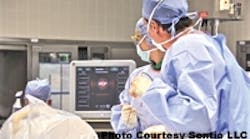When a once-booming business manufacturing parts for top industrial companies screeches to a halt, it's time to bring out your business Plan B. That's what a number of manufacturers experienced during the Great Recession, especially those tied closely to the automotive market. And for many of them, Plan B involved shifting at least part of their production to the health care market.
"The first step is to follow the money and determine where the growth will occur. The U.S. health care sector is already seeing and will continue to see increased investment," explains Simon Jacobson, research director at Gartner. "The next step is to look at your competencies and see how they can be adapted."
For companies making this transition, innovation is a critical factor in propelling them down a time-tested path. "We will do what we have always done. There is a natural evolution. High-tech moved to electronics and now industrial companies will move towards medical devices," Jacobsen says.
The medical sector should receive a boost via the Advanced Manufacturing Partnership announced by President Obama, says Jacobson. This program is designed to bolster the development of emerging technologies by improving coordination among businesses, universities and government agencies. Jacobson points out that this effort will move biotech and related applications front and center.
No one needed to tell Detroit that moving to other industries, including medical devices, was the way to go. "About three years ago, the automotive industry literally stopped. And I mean to a dead end -- nothing was moving," explains Irene Spanos, senior business development representative for Oakland County in Michigan.
City, county and state officials spent very little time counting their losses and instead geared up to find new sectors that could benefit from local employers' collective knowledge. Having shored up their supply chains, become adept at lean methods and created a highly skilled workforce, there were many companies well positioned to adapt these talents in other areas.
Oakland County stepped in by determining which companies could be saved and then helped them diversify. Classes, including Medical Devices 101, were offered with the state providing funds to assist companies in securing the necessary certifications to manufacture in this field. Training dollars were also available to help adapt workers' skills to the new tasks. And guaranteed loan programs financed tooling purchases. A network of consultants, including retired FDA directors, supplied the necessary industry knowledge.
Branching Out
One company that took the plunge into the health care market was Advanced Research Co. For over 20 years, the company had served customers such as American Axle and Manufacturing with hardware/software designs, product development and RFID solutions. During the recession, President William Sharp saw his business wilt when the sectors he served "just died."
"So I looked around to see how I could help other sectors run more efficiently," explains Sharp.
His strongest product was an RFID solution to track spare parts in the auto industry. In 2003 he offered this product within his field, complete with a three-month ROI, but no one had the funds to purchase the technology. However, the medical industry presented an area of opportunity. Increasing pressure to find cost savings, combined with rudimentary systems to control the flow of material, created a need that Advanced Research could fill.
Targeting the supply chain of orthopedic implants, he found a partner who was able to supply RFID tags that could be affixed to metal cabinets used for storage in hospitals. His partner knew the market and this enabled Advanced Research to re-develop and repackage its solution.
Their break came when Northwest Memorial Hospital was seeking this type of solution for a variety of its high-dollar items. The hospital had already done work on creating a more productive workflow, and the RFID solution was the next step in their improvement process.
"We won over our competitors for this business due to our automotive history. They knew we were experts at moving and tracking material. Plus we were able to customize to their needs. In the automotive sector a lot is customized but hospital suppliers didn't tend to offer that flexibility," explains Sharp.
The company developed customized cabinets, which can be used in all parts of the hospital including operating rooms, that were able to track the flow and supply of inventory. One especially useful application of the increased visibility was the ability to keep track of expiration dates of medicine. This enabled hospital employees to use the medicines in a more logical order or to transfer them to other facilities where they were needed.
"I believe that hospitals will be asking the same questions that the automotive plants asked with regard to managing material and using lean techniques. My company, and the automotive industry in general, has perfected many of these practices and therefore is in a unique position to help the health care industry," Sharp said.
Oakland County's Spanos echoes Sharp's view of the future. "This recession has been different for Michigan manufacturers who in the previous recession simply returned to their former customers when things picked up. Now they view their future as solidly rooted in different sectors and are seeking ways to continue that growth."
However, moving from automotive to medical isn't without its challenges. "Quality control in the medical field is very different from automotive," explains Stephen Bartol, CEO of Sentio LLC. "It was a real challenge."
His company used technology that was developed for use as an air-bag sensor and adapted it to a nerve-mapping device used by surgeons. In 2007 he built the first product on his kitchen table. (He is a surgeon and his partner is a biomedical engineer.) The device was able to map and locate nerves during surgery, which was especially useful in spinal surgeries.
They found a partner in BGM Engineering, Inc., which manufactured the sensor for airbags.
"The partnership was ideal as BGM was looking to diversify and we could provide a product to do that," Bartol says.
The success of that partnership has brought a lot of medical-device start-ups knocking on BGM's door, according to Joe Mazur, CEO of BGM. "The automotive sectors' stringent quality controls and processes in general makes for an easy transition into the medical field's layers of scrutiny."
Sentio is now FDA-approved as a result of the two companies working closely with engineers who were very familiar with the regulations. The company produces software in-house and contracts with another Michigan manufacturer to supply the tool that the surgeon holds.
Securing Talent
The company is growing so quickly that earlier this month it opened a new research and development center in Southfield, Mich. One reason for expanding in Michigan was the "entrepreneurial spirit combined with strong engineering talent" Bartol said.
Recognizing, redeploying and retraining talent is something that Michigan is proficient at. The state offered training dollars to companies moving from automotive and other industry sectors to the medical sector. An Emerging Technology Fund offers matching funds for NIH grants.
Educational resources, provided by Oakland Community College under the Michigan New Training Program, pay for new employees to be trained at the college. The college has an entire campus dedicated to life sciences and can provide two-year certificates all the way to a Ph.D.
While the right resources are necessary for success, sometimes it's the partners that make all of the difference. Kevin Lasser parlayed a small investment into a successful company by finding the right partners. Lasser is a tough-talking CEO, at least when it comes to his mandate to use Michigan talent and know-how.
-- Kevin Lasser, CEO, JEMs Technology
The product consists of a variety of parts, most with a Michigan connection. Rave Computer of Sterling Heights manufactures the video server, while Logic Solutions of Ann Arbor wrote the code, and Clinecta, also of Sterling Heights, does the training and integration. "The secret to our success is our vendors and we have it all right here in Michigan. Money and jobs are staying in Michigan," Lasser says.
An important tool in building up the medical sector in Michigan is a group called Medical Main Street. "Not only do we help companies design and manufacture the products here in Michigan, we also connect them to the hospitals and physicians who do the buying of these products. Our hospitals and physicians, some of whom sit on the board of our organization, have been very supportive and are an integral partner in the success of these new companies," says Spanos.
In the past two years, Medical Main Street has secured $76 million in investment for 20 companies that have created 1,626 jobs and retained 617 jobs. This group sits under the umbrella of Oakland County's Emerging Sectors group, which has generated more than $1.6 billon of new investment and has created or retained 34,000 jobs in the county since 2004.
"At the end of the day success will depend on the age-old formula of figuring out how to serve new customers in a new industry," says Gartner's Jacobson.





